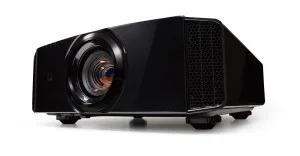JVCKenwood used Cedia to unveil three new lamp-based projectors that add HDMI 2.0a connectivity along with HDR functionality. These are all e-shift 4K models based upon a 1080p imager chip set. Demos of these projectors were impressive as were the price points.
The three models are the Procision series DLA-X550R, DLA-X750R and DLA-X950R, which also sold as the Reference Series DLA-RS600, DLA-RS500, and DLA-RS400. They offer 1700, 1800 and 1900 lumens (up 20-50% from current models) and 40:000:1, 120:000:1 and 150,000:1 native contrast ratios with dynamic contrast ratios that are ten times as high. All ship at the end of November for $4K, 7K and $10K with 2, 3 and 5 year warranties, respectively. All are lamp-based models but can achieve the cinema, DCI-P3 color gamut, via a movable yellow notch filter. Calibration and the P3 color space will reduce the peak luminance.
To support HDR, JVC has added two HDMI 2.0a ports. These are full speed 18 Gbps ports with HDCP 2.2 content protection included. HDMI 2.0a allows 4K/60p 4:2:0 with 16 bits per color, 4:2:2 with 8, 10 or 12 bits per color or 4:4:4 with 8 bits per color. It can also show 4K/24p 4:4:4.
HDR support means the projector can read static metadata (SMPTE 2086) in the HDMI stream and implement the PQ gamma curve (SMPTE 2084) in the projector. According to JVC, this was nearly completed as demonstrated at Cedia but the finished version will ship with the production models.
Delivering HDR content to the projector is a different issue. Today, only Amazon is delivery HDR content to UHDTVs, which requires the addition of an App to the TV to receive and decode the HDR signal. JVC does not anticipate installing an Amazon App on its projector, but the projector should be able to receive HDR content from capable Blu-ray players as they roll out. The nVidia Shield GPU card is also thought to support delivery of HDR content using SMPTE 2084/2086. Other outboard devices are anticipated that can support HDR signaling. The source device will read the EDID data from the projector and send HDR content if available. This will be recognized by the projector which will automatically switch into HDR mode.
JVC was showing the HDR capability running content from a Sony server. Content could be changed from the SDR to the HDR versions quite easily. The picture adjustment menu for the projectors is shown below. Moving from SDR to HDR mode changes the color profile (to P3) and the gamma (to PQ). Otherwise, the settings were the same.
Day and nighttime content taken in Japan was shown – unfortunately, captured on an overcast day. The photo below seems to best illustrate the improvement that HDR processing added – the ability to see blue sky and clouds in what was a uniform overcast sky in the SDR version. Other examples included sharper lights that were otherwise blown out and slightly more vibrant colors. Despite the huge contrast ratio and a very dark demo environment, there was not a lot of “pop” in the content due to the fairly low lumen output. Maybe it was the content, but the HDR impact was more subtle than I have seen on other demos.
As mentioned earlier, these are e-shift models, which means a 1080 panel set is in the engine, plus a “shifter” element that moves the image a ½ pixel up and over to display a second field of information. As TI showed at CEDIA, JVC’s implementation, at least in the model that TI was using, showed flaws in the display of fine lines and text. But the display of video content as shown in the JVC booth showed no ill effects. It looked very smooth with great color saturation. So although the algorithms would have issues if the projector was used as a graphics monitor, for video, it appears to be more than adequate.
The DLA-X950R/RS600 and DLA-X750R/RS500 are also THX 3D Certified and all 2016 JVC projectors offer an Auto Calibration Function that can, with the use of a widely available third party optical sensor, automatically calibrate the image to optimize the picture for various environments. In addition, this can also compensate for the changing color balance that occurs with long-term projector usage so the projector can continue to deliver optimal performance.
Finally, all 2016 JVC projectors include Control4 SDDP (Simple Device Discovery Protocol) so they can easily be integrated into a Control4 home automation system. – CC

